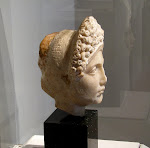 "The main banquet hall was circular and constantly revolved day and night, like the heavens."
"The main banquet hall was circular and constantly revolved day and night, like the heavens."
-Suetonius, De Vita Caesarum
This short passage about Nero's dining room has made scholars scratch their heads for as long as people have studied Suetonius. What was this room like? What exactly rotated and how did it work? Did the room even exist, or was it another of Suetonius' anecdotes to help paint Nero as a depraved tyrant? These questions may finally receive answers, thanks to archaeologists in Rome. On the Palatine Hill, they have discovered new remains of the Domus Aurea, Nero's golden house. Archaeologists discovered a massive four meter wide pillar which they believe supported the revolving dining room. Like all archaeological finds, there is a certain amount of interpretation involved and this matter can't be seriously discussed until the findings are published (in a peer reviewed journal that is, not an online news source). This find is extremely unique and nothing comparable is know, so it is convincing that this could have been where Nero dined. I'm very excited to find out more about this unique and potentially groundbreaking discovery.
Nero stared construction on his Domus Aurea (golden house) after the great fire of Rome in 64 CE. The fire cleared large areas of timber construction, giving Nero the room to pursue his architectural fantasies. Unfortunately, not much of the original structure remains and little has been excavated; much was torn down in antiquity or is now covered by post-antique construction. It is estimated that the Domus Aurea was between 100 and 300 acres in size and according to ancient sources (and archaeological remains) it was richly decorated. It obviously wasn't made entirely of gold; the name stems from the rich accoutrements and gilding that was found throughout the palace. Other famous attributes of the Domus Aurea were of course the revolving dining room, the Colossus of Nero and the large lake. For all its splendor, the Domus Aurea was short lived. Nero committed suicide in 68 CE and the victor in the civil war that followed, Vespasian, was a different kind of man and emperor. Vespasian rightly viewed the Domus Aurea as a contemptible exercise in greed and excess. Vespasian would gain fame by converting the site of Nero's lake into the Colosseum, the name of which was derived from the Colossus of Nero that stood near by. The colossus remained, but its dedication to Nero did not; it was rededicated to and altered to look like the sun god Helios. Today, the only accessible areas of the Domus Aurea are beneath the Baths of Trajan. These remains house wonderful Fourth Style frescoes that helped inspire Renaissance and Neo-Classical artists.





